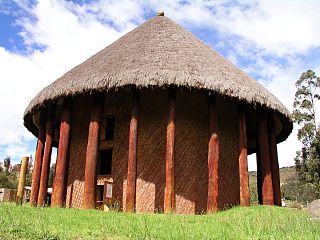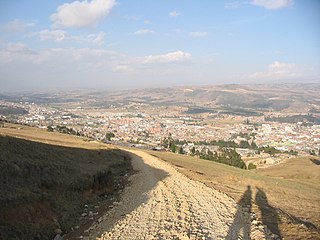 W
WAztec mythology is the body or collection of myths of Aztec civilization of Central Mexico. The Aztecs were Nahuatl-speaking groups living in central Mexico and much of their mythology is similar to that of other Mesoamerican cultures. According to legend, the various groups who were to become the Aztecs arrived from the north into the Anahuac valley around Lake Texcoco. The location of this valley and lake of destination is clear – it is the heart of modern Mexico City – but little can be known with certainty about the origin of the Aztec. There are different accounts of their origin. In the myth the ancestors of the Mexica/Aztec came from a place in the north called Aztlan, the last of seven nahuatlacas to make the journey southward, hence their name "Azteca." Other accounts cite their origin in Chicomoztoc, "the place of the seven caves," or at Tamoanchan.
 W
WThe goddess Bachué, is a mother goddess that according to the Muisca religion is the mother of humanity. She emerged of the waters in the Iguaque Lake with a baby in her arms, who grew to become her husband and populated the Earth. She received worshipping in a temple, in the area now within the municipality of Chíquiza, formerly called "San Pedro de Iguaque".
 W
WBochica is a figure in the religion of the Muisca, who inhabited the Altiplano Cundiboyacense during the arrival of the Spanish conquistadors in the central Andean highlands of present-day Colombia. He was the founding hero of their civilization, who according to legend brought morals and laws to the people and taught them agriculture and other crafts.
 W
WChaquén was the god of sports and fertility in the religion of the Muisca. The Muisca and their confederation were one of the four advanced civilizations of the Americas and as they were warriors, sports was very important to train the fighters for wars, mainly fought between the zipazgo and the zacazgo but also against other indigenous peoples as the Panches, Muzos and others. When the Spanish arrived in the highlands of central Colombia, the Altiplano Cundiboyacense, they encountered resistance of the guecha warriors, trained by Chaquén.
 W
WThe goddess Chía, is a triple goddess in the religion of the Muisca who inhabited the Altiplano Cundiboyacense in pre-Columbian times. Of central importance to the pantheon, she was worshipped across various Muisca lands.
 W
WChiminigagua, Chiminichagua or Chimichagua was the supreme being, omnipotent god and creator of the world in the religion of the Muisca. The Muisca and their confederation were one of the four advanced civilizations of the Americas and developed their own religion on the Altiplano Cundiboyacense in the Andes.
 W
WEl Dorado, originally El Hombre Dorado or El Rey Dorado, was the term used by the Spanish in the 16th century to describe a mythical tribal chief (zipa) of the Muisca people, an indigenous people of the Altiplano Cundiboyacense of Colombia, who, as an initiation rite, covered himself with gold dust and submerged in Lake Guatavita. The legends surrounding El Dorado changed over time, as it went from being a man, to a city, to a kingdom, and then finally to an empire.
 W
WIdacansás, Idacansas, Idacanzas or Iduakanzas was a mythical cacique who was said to have been the first priest of the sacred city of Sugamuxi, present-day Sogamoso, Colombia, then part of the territories of the Muisca. He is characterized by his great magical powers as he could make rain and hail and transmit diseases and warmth.
 W
WInca mythology includes many stories and legends that attempt to explain or symbolize Inca beliefs.
Maya or Mayan mythology is part of Mesoamerican mythology and comprises all of the Maya tales in which personified forces of nature, deities, and the heroes interacting with these play the main roles. The myths of the Pre-Hispanic era have to be reconstructed from iconography. Other parts of Mayan oral tradition are not considered here.
 W
WThe terms Muisca religion and mythology refer to the pre-Columbian beliefs of the Muisca indigenous people of the Cordillera Oriental highlands of the Andes in the vicinity of Bogotá, Colombia. The tradition includes a selection of received myths concerning the origin and organization of the universe. Their belief system may be described as a polytheistic religion containing a very strong element of spirituality based on an epistemology of mysticism.
 W
WNencatacoa or Nem-catacoa was the god and protector of the mantle makers, artists and festivities in the religion of the Muisca. The Muisca and their confederation were one of the advanced civilizations of the Americas; as much as the Aztec, Mayas and Incas but other than the other three, they did not construct grand architecture. Their gold working however was well-known and respected which made Nencatacoa an important deity and protector.
 W
WThe religion of the Olmec people significantly influenced the social development and mythological world view of Mesoamerica. Scholars have seen echoes of Olmec supernatural in the subsequent religions and mythologies of nearly all later pre-Columbian era cultures.
 W
WPacanchique was a person in the mythology of the Muisca. He is said to have been the son of the cacique of Ramiriquí; Baganique. During that time, Ramiriquí was part of the zacazgo of Quemuenchatocha of the northern Muisca Confederation. Pacanchique's fiancé, Azay, is said to have been kidnapped by Quemuenchatocha and Pacanchique did all to get her back, eventually leading the Spanish conquistadores to Hunza to beat Quemuenchatocha.
 W
WThe Purépecha religion is the religion of the Purépecha people.
 W
WSué, Xué, Sua, Zuhe or Suhé was the god of the Sun in the religion of the Muisca. He was married to Moon goddess Chía. The Muisca and their confederation were one of the four advanced civilizations of the Americas and developed their own religion on the Altiplano Cundiboyacense in the Andes. Both the Sun and rain, impersonated by Chibchacum, were very important for their agriculture.